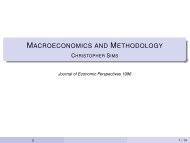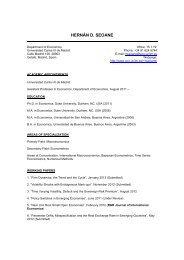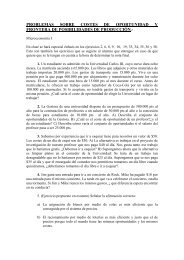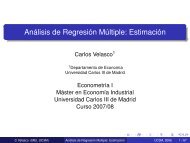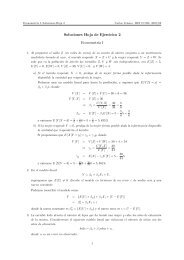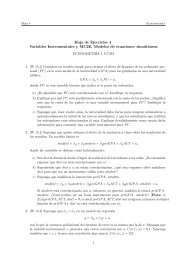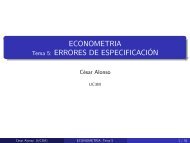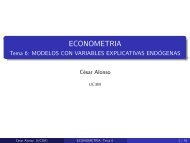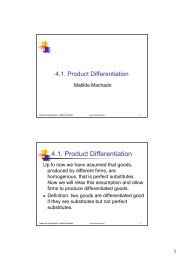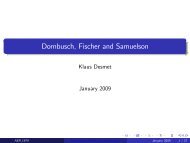Estimating Trade Flows: Trading Partners And Trading Volumes
Estimating Trade Flows: Trading Partners And Trading Volumes
Estimating Trade Flows: Trading Partners And Trading Volumes
Create successful ePaper yourself
Turn your PDF publications into a flip-book with our unique Google optimized e-Paper software.
<strong>Estimating</strong> <strong>Trade</strong> <strong>Flows</strong>: <strong>Trading</strong> <strong>Partners</strong><br />
<strong>And</strong> <strong>Trading</strong> <strong>Volumes</strong><br />
Elhanan Helpman, Marc Melitz & Yona Rubinstain (2008)<br />
Presented by Camilo A. Ulloa<br />
March 17, 2009
1 Introduction<br />
Gravity equations (Timebergen, 1962):<br />
T Fij : f Economic sizeij; T rade resistenceij<br />
Traditional estimates of trade ‡ows using gravity equations are biased:<br />
– They include only countries with positive trade ‡ows between them.<br />
,! Heckman selection bias.<br />
– They impose symmetry in the trade ‡ows between pairs of countries.<br />
,! Omitted variable bias: fraction of exporting …rms (i.e., extensive<br />
margin of trade).
In this paper, the authors develop a theoretical model of international trade<br />
with productivity heterogeneous …rms (Melitz 2003).<br />
(i) The model is able to predict positive as well as zero trade ‡ows.<br />
(ii) The model can predict positive, but asymmetric, bilateral trade ‡ows.<br />
(iii) The model generates a generalized gravity equation (<strong>And</strong>erson and van<br />
Wincoop, 2003)<br />
,! The impact of trade frictions on trade ‡ows can be decomposed:<br />
– Intensive margins: <strong>Trade</strong> volume per exporter.<br />
– Extensive margins: Number of exporters.
2 A Glance at the data.
Thus, the empirical evidence suggest that:<br />
(i) About 50% of the country pairs do not trade between them.<br />
(ii) The world trade growth from 1970 to 1997 was predominantly due to the<br />
growth of the volume of trade among countries that traded with each other<br />
in 1970.<br />
(iii) Bilateral trading volumes in 1997 of countries that traded in both directions<br />
since 1979 have been much larger than bilateral trading volumes of<br />
countries that did not trade in both directions (35 times larger on average).
3 Theory.<br />
There are J countries, j = 1; 2; :::; J. Each of them consumes and produces<br />
a continuum of products. Country j 0 s preferences are described by<br />
the following utility function (CES).<br />
where:<br />
uj =<br />
" Z<br />
l2Bj<br />
xj (l) dl<br />
– xj (l) : Consumption of product l.<br />
# 1=<br />
; 0 < < 1;<br />
– Bj : Set of products available for consumption in j.<br />
– " = 1=(1 ) : Elasticity of substitution across products.
Then, country j’s demand for product l is:<br />
where<br />
xj (l) = epj (l) "<br />
Yj 1 "<br />
Pj – epj (l) : price of product l in country j<br />
– Pj : country j’s ideal price index:<br />
Pj =<br />
" Z<br />
l2Bj<br />
# 1=(1 ")<br />
epj<br />
1 "<br />
(l)<br />
,! every product has a constant demand elasticity ".<br />
(1)<br />
(2)
Country j has a measure Nj of …rms, each one producing a distinct product,<br />
which is also distinct from the products produced by country-i …rms.<br />
Thus, there are P J j Nj …rms and products in the world economy.<br />
A country- j …rm faces a production cost cja per unit of output.<br />
– a : …rm speci…c unit requirements of country j 0 s inputs (i.e., domestic<br />
…rms only use domestic inputs).<br />
– cj : country speci…c cost of these inputs.<br />
,! Thus, 1=a is the …rm’s productivity level.<br />
It is assumed that a is distributed according to a common CDF for all<br />
countries, G (a), with support [a L; a H], and a H > a L > 0.
A country- j …rm that sells its product in country i faces 2 additional costs:<br />
– A …xed cost of serving country i: cjfij<br />
– A "melting iceberg" transport cost: ij<br />
,! fij and ij are not …rm speci…c.<br />
n<br />
fjj = 0; fij > 0 o<br />
n<br />
jj = 1; ij > 1 o<br />
There is monopolistic competition in …nal products. Thus (1) implies that a<br />
country- j producer with productivity 1=a will set a price: pj (a) = cja=<br />
If the country- j producer of l sells to consumers in country i, then sets a<br />
delivered price (in country i)<br />
cja<br />
(3)<br />
epj (l) = ij
Thus, the operating pro…ts from these sales to country i are:<br />
ij (a) = (1 )<br />
! 1 "<br />
ijcja<br />
Yi cjfij<br />
Pi<br />
,! Since fjj = 0; jj = 1 and 2 (0; 1) =) jj (a) > 0. That is, all<br />
Nj producers sell in country j.<br />
,! Moreover, sales in country i 6= j are pro…table i¤ a aij , where aij<br />
is de…ned by the zero pro…ts condition:<br />
(1 )<br />
! 1 "<br />
ijcjaij<br />
Yi = cjfij<br />
Pi<br />
(4)
Notice that:<br />
(i) Only a fraction G(aij) of country j0s Nj …rms export to country i<br />
=) Bi is smaller than the total set of world products.<br />
(ii) If aij aL =) G(aij) = 0 (i.e. The model can predict zero trade<br />
volumes).<br />
(iii) If aij > a L =) All …rms from country j export to i:
Let de…ne<br />
Vij =<br />
( R aij<br />
a L a 1 " G(aij) for aij > a L<br />
0<br />
Then, the demand function (1) and the pricing rule (3) imply that the<br />
value of country i’s imports from j is<br />
Mij =<br />
! 1 "<br />
cj ij<br />
YiNjVij<br />
Pi<br />
Furthermore the de…nition of the country i’s ideal price index (2) imply:<br />
Pi =<br />
JX<br />
j=1<br />
! 1 "<br />
cj ij<br />
NjVij<br />
Pj<br />
(5)<br />
(6)<br />
(7)
4 Empirical framework<br />
First, a completely parametric approach was implemented and then some<br />
of the parameterization assumptions were progressively relaxed.<br />
Baseline case: 1=a is Pareto distributed, truncated to the support [a L; a H].<br />
G (a) = ak ak L<br />
ak H<br />
ak ; k > (" 1)<br />
L<br />
,! aij < a L for some i j pairs is allowed (i.e., Mij = 0).<br />
,! Mij 6= Mji is also allowed (i.e., Mij = 0 and Mji > 0 or Mij > 0<br />
and Mji = 0).
Under the Pareto distribution assumption, (5) becomes:<br />
where<br />
Vij =<br />
Wij = max<br />
and aij is determined by (4).<br />
k "+1<br />
kaL (k " + 1) a k H ak L<br />
8<br />
<<br />
:<br />
! k "+1<br />
aij<br />
a L<br />
W ij<br />
1; 0<br />
9<br />
=<br />
;<br />
(8)
Rewriting (6) in log-linear form we get<br />
mij = (" 1) ln (" 1) ln cj+nj+(" 1) pi+yi+(1 ") ln ij+ ij<br />
It is assumed that the variable trade costs, ij,.that a¤ect the volume of<br />
…rm-level exports costs are stochastic.<br />
where:<br />
(" 1)<br />
ij D ij exp uij<br />
– Dij : Symmetric distance between i and j (observed trade friction).<br />
– uij i:i:d N 0; 2 u : Country-pair speci…c unmeasured (unobserved)<br />
trade frictions.
Then the log-linear representation of (6) yields the estimating equation<br />
where:<br />
– Constant term:<br />
mij = 0 + j + i dij + wij + uij (9)<br />
0 = (" 1) ln + ln h<br />
k "+1<br />
kaL = (k " + 1) a k H akL – Fixed e¤ect of the exporting country: j = (" 1) ln cj + nj.<br />
– Fixed e¤ect of the importing country: i = (" 1) pi + yi.<br />
– Country-pair speci…c factor which controls for the fraction of …rms that<br />
export from j to i: wij.<br />
The inclusion of this factor is the most important di¤erence with traditional formulations (i.e.,<br />
<strong>And</strong>erson and van Wincoop, 2003).<br />
i
Remark 1 Notice that:<br />
(i) If wij is not included, then the coe¢ cient on any trade barrier<br />
(i.e., ) can not be interpreted as the elasticity of a …rm’s trade<br />
with respect to that trade barrier (i.e., distance) =) Omitted variable<br />
bias.<br />
(ii) If country pairs with zero trade ‡ows are excluded, then:<br />
Corr(dij;uij)<br />
> 0<br />
For exmaple, country pairs with large observed trade barriers (i.e., high<br />
dij ) that trade, are likely to have low unobserved trade barriers (i.e.,<br />
high uij). =) Heckman selection bias.
4.1 Firm Selection into Export Markets (Wij : ' aij )<br />
Let de…ne the latent variable<br />
Zij =<br />
(1 ) Picj ij<br />
cjfij<br />
" 1<br />
1 "<br />
YiaL (10)<br />
That is, the ratio of variable export pro…ts for the most productive …rm<br />
(1=a L) to the …xed costs for exports from j to i.<br />
(k "+1)=(" 1)<br />
Notice that equations (4) and (8) imply that: Wij = Z ij<br />
,! a) Wij is a monotonic function of Zij; and b) Positive exports from country<br />
j to i are observed () Zij > 1.<br />
1
It is assumed that the …x trade costs, fij; are stochastic:<br />
where:<br />
fij exp EX;j + IM;i + k ij vij<br />
– EX;j : Country j …xed export costs common across all destinations.<br />
– IM;i : Country i …xed trade barrier imposed on all exporters.<br />
– ij : Any additional country-pair speci…c …xed trade costs.<br />
– vij i:i:d N 0; 2 u : unmeasured (unobserved) trade frictions, possible<br />
correlated with the uij.
Thus, taking into account that (" 1) ln ij ln dij uij, it follows<br />
that (10) can be rewritten in the log-linear form:<br />
where:<br />
zij = 0 + j + i dij ij + ij (11)<br />
– Constant term: 0 = [ln (1 ) + (" 1) ln ( =a L)]<br />
– Exporter …xed e¤ect: j = " ln cj EX;j.<br />
– Importer …xed e¤ect: i = (" 1) pi + yi IM;i<br />
– ij uij + vij i:i:d N 0; 2 with 2 = 2 u + 2 v
Let de…ne the indicator variable<br />
Tij =<br />
(<br />
1 ; country j exports to country i<br />
0 ;<br />
and let ij be the the conditional probability that country j exports to i.<br />
Then a Probit equation can be speci…ed as follows. y<br />
ij = Pr Tij = 1j observed variables<br />
= 0 + j + i d ij ij (12)<br />
where ( ) is de cdf of the unit-normal distribution.<br />
y In order to get a well speci…ed probit without, the equation (11) was divided by the standard<br />
deviation of the error term.
In this context, a consistent estimate for Wij can be obtained as<br />
where<br />
– b Z ij = exp bz ij = exp h<br />
Z ij<br />
exp zij=<br />
cWij = max b Zij 1; 0 (13)<br />
1 bij<br />
i<br />
is the predicted value of<br />
– b ij is the predicted probability of exports from country j to i.<br />
– (k " + 1) = (" 1)
4.2 Consistent Estimation of the Log-Linear Equation<br />
Consistent estimation of (9) requires consistent estimations of:<br />
E h<br />
wijjTij = 1; : i<br />
and E h<br />
uijjTij = 1; : i<br />
The …rst controls for the endogenous number of exporters, and the second<br />
for the selection of country pairs into trading partners.<br />
Notice that (11) implies that both terms depend on<br />
h<br />
= E<br />
In particular, E h<br />
uijjTij = 1; : i<br />
ij<br />
ijjTij = 1; : i<br />
= corr uij; ij ( u= ) ij
Since ij is unit-normal distributed, it follows that ij<br />
estimated from the inverse of the Mills ratio.<br />
b ij = bz ij = bz ij<br />
=) bz ij bz ij + b ij !p E h<br />
z ij jTij = 1; : i<br />
=) bw ij ln n<br />
exp h<br />
bz ij + b ij<br />
1 io<br />
can be consistently<br />
!p E h<br />
wijjTij = 1; : i<br />
Thus, consistent estimation of (9) can be obtained from the transformation<br />
mij = 0 + j + i dij +ln n<br />
exp h<br />
where E h<br />
eijjTij = 1; : i<br />
z Standard Heckman (1979) correction for sample selection.<br />
bz ij + b ij<br />
1 io<br />
+ u b ij +eij<br />
(14)<br />
= 0 and u corr uij; ij ( u= ). z
5 TRADITIONAL ESTIMATES<br />
Table I provides representative traditional estimates of the gravity equation<br />
(i.e., without biases’correction) and the estimates for the …rst stage Probit<br />
equation (12).<br />
– Unidirectional trade value for 158 countries.<br />
– Both equations were estimated for the year 1886 and for an extended<br />
sample period that cover all of the 1980s, adding year …xed e¤ects.<br />
– Additional estimates adding bilateral controls for WTO/GATT membership<br />
are also provided (sample period: 1980s).
Basic results:<br />
– In general, the same variables that have a signi…cant e¤ect on export<br />
volumes from j to i also have a signi…cant e¤ect on the probability<br />
that j exports to i.<br />
,! Strong evidence that traditional gravity equation estimates are biased.<br />
– Common religion strongly a¤ects the formation of trading relationships<br />
(the probability of trading) but has no e¤ect on the volume of trade.<br />
– WTO membership has a strong and signi…cant e¤ect on the formation<br />
of bilateral trading relationships (Subramanian and Wei, 2007).<br />
– The results are not speci…c to 1986. y<br />
An exception is land border that may be due to territorial border con‡icts.<br />
y The 1986 results can be compared with other studies. (i.e., Eaton et al, 2004).
6 TWO-STAGE ESTIMATION<br />
As was described in the previous sections, the estimation of the gravity<br />
equation (14) requires the estimation of a …rst-stage selection equation<br />
(such as the Probit equation 12).<br />
6.1 Identi…cation<br />
Notice that if no additional identi…cation restrictions are imposed (i.e.,<br />
valid excluded variables), then the identi…cation of the parameters in (14)<br />
relays on the normality assumption for the unobserved trade costs.
The economic model suggest that any trade barrier that a¤ect …xed trade<br />
costs but do not a¤ect variable trade costs is a valid excluded variable.<br />
– Country-level data on …rm’s entry regulation costs (Djankov et al, 02).<br />
(i) Regulation cost: f= 1g if the relative cost (% GDP per capita) of<br />
forming a business > median in country i and country j.<br />
(ii) Regulation cost (days and procedures): f= 1g if the sum of the<br />
# of days and procedures to form a business is > median in country<br />
i and country j.<br />
=) There is not available regulation cost data for 42 countries, Moreover,<br />
8 countries export to everyone and Japan imports from everyone in the<br />
remaining sample =) the available observations are reduced to a half.
6.2 Parameterization assumptions.<br />
In principle, the parameterization assumptions (i.e., Pareto cdf for G ( )<br />
and the uij+vij i:i:d N 0; 2 ) may play an important role in the results.<br />
1. Fully parametrized estimation: Probit equation (12) in the …rst step<br />
and NLS in the second step to estimate (14).<br />
2. Semiparametric method: The Pareto assumption for G ( ) was dropped<br />
and reverted and to the general speci…cation for V ij in (5):<br />
– First Stage: Form (4) & (10): ij (zij); can be any increasing<br />
function of zij. Thus, ( bz ij) was approximated with a polynomial<br />
in bz ij, and E h<br />
VijjTij = 1; : i<br />
was directly controlled using ( bz ij).<br />
– Second Stage: using OLS.
3. Nonparametric method: The joint normality assumption for the unobserved<br />
trade costs was relaxed.<br />
– First Stage: Probit equation in (12), but using directly the b ij,<br />
instead of using the normality assumption to recover the bz ij and<br />
b ij. y<br />
The obtained b ij were partioned into a number of bins (50 and<br />
100) with equal observations, and an indicator variable to every bin<br />
was assigned. This procedure allows to approximate an arbitrary<br />
functional form of the b ij in a ‡exible way.<br />
– Second Stage: using NLS.<br />
Mills ratio for the selection correction is not longer used.<br />
y Logit and t-distributions were also considerd and the results were strikingly similar.
Basic Results:<br />
– In general, the benchmark gravity equation leads to upward biased<br />
estimates of the trade frictions in the volume of trade. It confound the<br />
true e¤ect of these frictions with their indirect e¤ect on the proportion<br />
of exporting …rms.<br />
– The Pareto distribution assumption for G ( ) does not seem to a¤ect<br />
the general results.<br />
– The joint normality assumption for the unobserved trade costs does<br />
not seem to a¤ect the general results.
7 AN ALTERNATIVE EXCLUDED VARIABLE<br />
Notice that the results in the table II also suggest that common religion<br />
strongly a¤ects the formation of trading relationships (the probability of<br />
trading) but has no e¤ect on the volume of trade.<br />
In this section, this common religion variable is used as excluded variable<br />
in the estimation of (14).<br />
– First, the three estimation procedures applied to the reduced sample<br />
(i.e., previous section sample) are implemented.<br />
– Then, the estimation is extended to the full sample of countries.<br />
Table III provides the estimation results.
Basic Results:<br />
– Religion is a legitimate excluded variable, and can be used to estimate<br />
the model on the full sample of countries.<br />
– Estimated trade frictions in the benchmark gravity equation are con-<br />
…rmed to be biased.<br />
– By increasing the country coverage it is possible to study how the biases<br />
vary with country pairs’characteristics.
8 ADDITIONAL INSIGHTS<br />
8.1 Decomposing the Biases<br />
To examine the relative importance of the standard gravity equations<br />
biases, two speci…cations of the second-stage equation (14) were estimated<br />
(see Table IV).<br />
1. Correcting the unobserved heterogeneity bias (i.e., adding bz ij = 1 bij<br />
as regressor to the benchmark gravity equation).<br />
2. Correcting the selection bias (i.e., adding b ij as regressor to the benchmark<br />
gravity equation).
,! unobserved heterogeneity bias dominates.
8.2 Evidence on Asymmetric <strong>Trade</strong> Relationships<br />
In this subsection it is studied whether the predicted asymmetries (…rst<br />
stage estimation) can explain the direction of trade ‡ows and net bilateral<br />
trade balances (see Table V).<br />
1. OLS regression of Tij Tji on b ij b ji.<br />
2. OLS regression of mij mji on the di¤erences in the proportion of<br />
exporting …rms:<br />
– bw ij<br />
bw ji, in the NLS speci…cation.<br />
– b( bz ij) b( bz ji), in the polynomial approximation.
,!The predicted asymmetries have explanatory power for the direction of trade<br />
‡ows and net bilateral trade balances.
8.3 Counterfactuals<br />
Counterfactual experiment: The distance trade cost decreases in 10%<br />
d 0 ij<br />
dij = log 0:9<br />
– The study is focused on the elasticity of the overall trade response for<br />
each country pair:<br />
cm 0 ij mij = d 0 ij dij<br />
(i) These elasticities vary along country pair income. =) Summary<br />
statistics across three groups of country pairs are reported (see Table<br />
VI).<br />
(ii) The elasticity response at the intensive margin is …xed at 0.799 (NLS)<br />
and 0.862 (polynomial approximation) =) the heterogeneity in the<br />
predicted elasticity response is due to the extensive margin.
,! The heterogeneous trade responses show that the variation of these elasticities<br />
is large.<br />
Figure III depicts the distribution of these elasticities across country pairs<br />
group.
,! When trade costs related to distance fall, the response of the extensive<br />
margin of trade is predicted to be larger for less developed countries.




